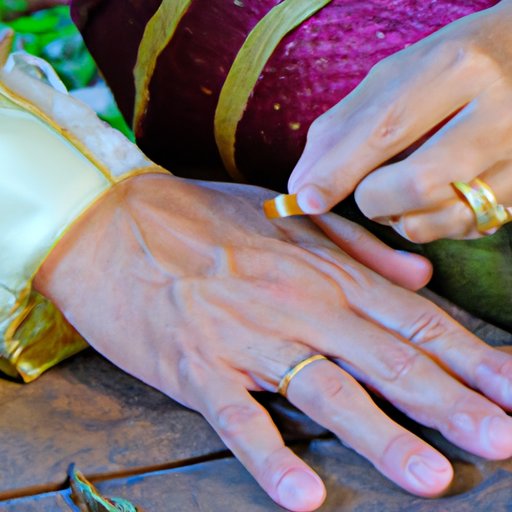Introduction
For many cultures around the world, the wedding ring has become an important symbol of love and commitment. But have you ever wondered why the wedding ring is traditionally worn on the left hand? In this article we will explore the history, symbolism, and traditions behind why the wedding ring is worn on the left hand, to better understand its significance.
Exploring the History of Why the Wedding Ring is Worn on the Left Hand
The practice of wearing a wedding ring dates back thousands of years, with the earliest known example being from ancient Egypt. While there is no definitive answer as to why the wedding ring was first placed on the left hand, the most widely accepted theory is that the Egyptians believed the “vein of love” ran directly from the fourth finger of the left hand to the heart. This vein was thought to be the pathway for love to enter the body, thus making the left hand the ideal place to wear a wedding ring.
Since then, the practice of wearing a wedding ring on the left hand has evolved over time. In medieval Europe, it was customary to wear a ring on the left hand to signify that a woman had been married, while in some Asian countries, the wedding ring is still worn on the right hand. Today, the majority of Western countries follow the tradition of wearing the wedding ring on the left hand.

Unveiling the Symbolic Meaning Behind Wearing a Wedding Ring on the Left Hand
The placement of the wedding ring on the left hand has come to represent a universal symbolism of love and commitment across cultures. For many people, the left hand is associated with the heart, making it the perfect spot for a wedding ring to be placed. The left hand is also seen as the receiving hand, signifying that the ring recipient is open to receiving love from their partner.
The significance of the left hand goes beyond just symbolism, however. In some cultures, the left hand is considered to possess spiritual power and is used for certain rituals or ceremonies. This further reinforces the idea that the left hand is the ideal place to wear a wedding ring, as it is a way of honoring the love between two people.

Examining Cultural Traditions Around the Placement of the Wedding Ring
Different countries around the world have their own unique customs when it comes to the placement of the wedding ring. In some countries, such as India, the wedding ring is placed on the right hand. This is thought to signify that the couple is now part of one family, united together by marriage. In other countries, such as Germany, the wedding ring is placed on the thumb. This is said to represent the couple’s strength and bond, as well as their ability to overcome any obstacles.
In addition to regional variations in the placement of the wedding ring, some cultures have different meanings associated with the left hand. For example, in some parts of the Middle East, wearing the ring on the left hand is seen as a sign of wealth and prosperity, while in some African countries it is seen as a sign of fertility.

Investigating How Different Religions View the Significance of the Left Hand for Wedding Rings
The importance of the left hand for wedding rings varies among different religions. For Christians, the left hand is seen as the weaker hand, and placing the ring on it is a reminder of the need for humility. In Judaism, the left hand is seen as the side of kindness and mercy, and the wedding ring is placed there to remind the couple to remain kind and merciful towards each other. In Islam, the left hand is seen as the “hand of Allah” and wearing the wedding ring on it is a sign of devotion to Allah.
Analyzing the Scientific Reasons for Why the Wedding Ring is Worn on the Left Hand
There are several physiological and neurological reasons why the wedding ring is traditionally worn on the left hand. For starters, the left hand is controlled by the right side of the brain, which is responsible for emotion and intuition. This suggests that wearing the wedding ring on the left hand is a subconscious way of emphasizing the emotional connection between the couple. Additionally, the left hand is linked to the sympathetic nervous system, which is responsible for calming and soothing the body. This could explain why wearing a wedding ring on the left hand has a calming effect on the wearer.
Understanding the Practical Benefits of Keeping the Wedding Ring on the Left Hand
Aside from the symbolic and scientific reasons, there are also practical benefits to keeping the wedding ring on the left hand. For one, it is easier to remember which finger the ring is on since the majority of people are right-handed. Additionally, having the wedding ring on the left hand makes it more convenient during daily activities, such as typing on a keyboard or shaking hands with someone.
Conclusion
In conclusion, wearing the wedding ring on the left hand is a tradition that dates back thousands of years, and it has come to represent a universal symbolism of love and commitment across cultures. The left hand is also seen as a receiving hand, and is linked to the right side of the brain, which is responsible for emotion and intuition. Furthermore, there are practical benefits to keeping the wedding ring on the left hand, such as convenience during daily activities. Understanding why the wedding ring is worn on the left hand can help us better appreciate its significance and importance.


